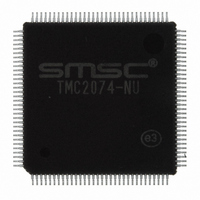TMC2074-NU SMSC, TMC2074-NU Datasheet - Page 27

TMC2074-NU
Manufacturer Part Number
TMC2074-NU
Description
IC CTRL CIRC 128VTQFP PERIPH MOD
Manufacturer
SMSC
Series
CircLink™r
Datasheet
1.TMC2074-NU.pdf
(116 pages)
Specifications of TMC2074-NU
Controller Type
I/O Controller
Interface
Transceiver
Voltage - Supply
3 V ~ 3.6 V
Current - Supply
40mA
Operating Temperature
0°C ~ 70°C
Mounting Type
Surface Mount
Package / Case
128-TQFP, 128-VQFP
Lead Free Status / RoHS Status
Lead free / RoHS Compliant
Other names
638-1024
Available stocks
Company
Part Number
Manufacturer
Quantity
Price
Company:
Part Number:
TMC2074-NU
Manufacturer:
SMSC
Quantity:
897
Company:
Part Number:
TMC2074-NU
Manufacturer:
Microchip Technology
Quantity:
10 000
Part Number:
TMC2074-NU
Manufacturer:
SMSC
Quantity:
20 000
Part Number:
TMC2074-NU-E3
Manufacturer:
SMSC
Quantity:
20 000
Dual Mode CircLink™ Controller
Datasheet
2.4
2.4.1
2.4.2
SMSC TMC2074
CircLink Protocol Enhancement
Since ARCNET communication is controlled by a token, token loss and the corresponding network
reconfiguration significantly reduce network throughput. The CircLink controller design includes
enhancements to and modifications of the ARCNET protocol to increase reliability and performance.
Reducing Token Loss
The burst signal is the primary cause of token loss. The burst signal is part of the sequence for new nodes
joining the network as described in section 2.3. but with CircLink all nodes join the network at system start-
up. If a node leaves the network due to token loss it can readily rejoin the network in the next polling with
no burst necessary. In order to avoid this burst signal, the ARCNET protocol has been modified to specify
node IDs as consecutive numbers starting from 01. When a node other than the node having the largest
node ID (NID [4:0] and MAXID[4:0]) sends a token with the starting address being the node ID +1, the
token can be received in the next polling, even if the node had previously dropped out of the network.
The token retry function added to CircLink greatly reduces the possibility of not receiving the response
from the logical neighbor due to token corruption. CircLink node IDs are consecutive and since the retry
does not occur under normal conditions, the token retry function does not degrade the total performance.
This function can be set to ON or OFF using software settings (default is ON).
Another cause of token loss is the corruption of ACK/NAK. In the ARCNET flow control (refer to page 12 in
the ARCNET controller COM20020I datasheet), if the source node receives signals other than the
anticipated ACK/NAK response (such as noise or, data-deformed ACK/NAK and the like) from the
destination node, the source node returns to the receive-wait state with a token being held by the node.
The network considers this token loss because the token disappears from the network. To avoid this
problem, the ARCNET protocol has been modified in CircLink to send a token even after the detection of
ACK/NAK corruption This function can be set to ON or OFF (default is ON).
Reduction of Network Reconfiguration Time
To reduce the required time of (255 - ID) x 146 μs* during network reconfiguration , CircLink designates a
node with the maximum ID as the maximum node (MAX_NODE). This node immediately starts sending
tokens with destination numbers starting from 00. The token sent to 00 is not received by any node but
triggers the other nodes to enter into the receive state after the (255 - ID) x 146 μs* time is over. In
addition, The (255 - ID) x 146 μs* timer formula, derived from ARCNET, is modified to (The maximum
number of nodes –ID) x 146 μs depending on the maximum number of nodes, which is specified by the
MAXID [4:0] pin. This modification makes significantly reduces the time required for network
reconfiguration even in the absence of the node designated as MAX_NODE.
* 146 μs is defined under operation at 2.5 Mbps based on ARCNET protocol. The time is half at 5 Mbps..
DATASHEET
Page 27
Revision 0.2 (10-23-08)













